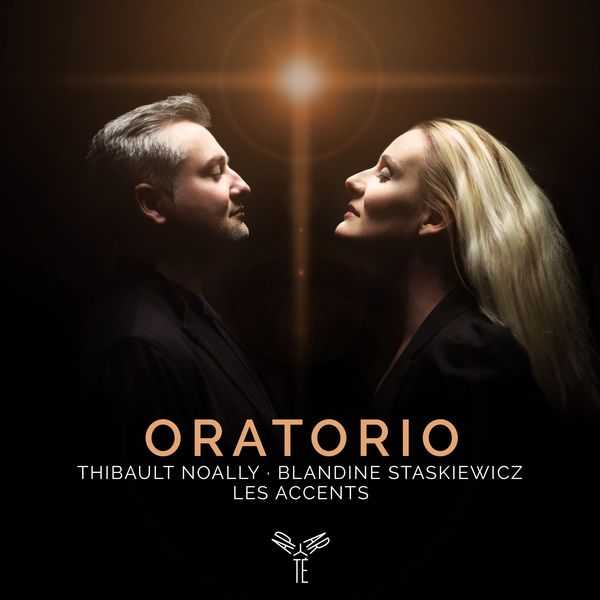

Composer: Giovanni Battista Bononcini, Antonio Caldara, Francesco Gasparini, Johann Simon Mayr, Nicola Antonio Porpora, Alessandro Scarlatti
Performer: Blandine Staskiewicz, Les Accents
Conductor: Thibault Noally
Format: FLAC (tracks)
Label: Aparté
Catalogue: AP178
Release: 2018
Size: 1.21 GB
Recovery: +3%
Scan: yes
Caldara: La Castita al Cimento
01. Ombre, cure, sospetti
Caldara: Maddalena à piedi di Cristo
02. Per il mar del pianto mio
Bononcini: La Converzione di Maddalena
03. In tepidi fiumi
Gasparini: Atalia
04. Ombre, cure, sospetti
05. Terrori d’Averno
Porpora: Il Trionfo della Divina Giustizia
06. Vanne o Sol d’eterna luce
Scarlatti: San Casimiro rè di Polonia
07. Miei spirti guerrieri
Bononcini: La Converzione di Maddalena
08. Al sibilar tremendo
09. In tepidi fiumi
Porpora: Il Trionfo della Divina Giustizia
10. Ecco già l’orrenda tromba
Scarlatti: Giuditta
11. Del pianto vostro
12. Posso e voglio
Caldara: Santa Francesca Romana
13. Miro che fiumicello
Porpora: Il Martirio di San Giovanni
14. Vanne nel vicin tempio
15. Fremer da lunge io sento
Scarlatti: Il Gardino di Rose
16. Mentre io godo
Caldara: Il Martirio di San Giovanni
17. Ombre, cure, sospetti
Since its foundation in 2014, Thibault Noally’s ensemble Les Accents brings to life rare works from the Italian Baroque era: in particular the vocal repertoire of the 17th and 18th centuries. Their new record features unpublished extracts of oratorios. Born at the same time and made of the same theatrical stuff as his opera brother, the oratorio, a lyric and dramatic work without staging, also moves the crowds! And its heroines Athalie and Judith have the same temper as their operatic counterparts. The virtuoso arias of Caldara, Scarlatti (father) or Porpora performed by the mezzo-soprano Blandine Staskiewicz, full of baroque ornaments and jubilant flights, also testify to the instrumental ardor of the genre: the dramatic effects of the orchestra, the alternation of allegros and adagios, and the various of playing modes marry the movements of the passions of these characters with great intensity.
With this new recording, Thibault Noally and his ensemble Les Accents are providing a portrait of the genre of the oratorio at the turn of the 17th and 18th centuries, in four stylistic schools: Naples, Rome, Venice and Vienna, in the hands of Scarlatti-père, Caldara, Porpora, Bononcini and Gasparini. From prayer to fury, and with plenty of vocal fireworks, these pieces (nine of them have never been released yet) have been selected especially for Blandine Staskiewicz and are perfect examples of balance between the quality of musical material, dramatic tension in the lyrics, and fervent feeling. The “oratorio”, in the context of the Counter-Reformation, made a return to scripture, and so mixed art with religious meditation. Its first musical forms foregrounded “speaking-singing” or what would later be called recitative, and continuo. At the time, there wasn’t much separating oratorio from opera. It’s not even the case that the oratorio dropped visual performances: in Napes, Rome and Vienna, a number of oratorios were given in with sumptuous decor and costumes. As for musical forms, the oratorio follows the example of its stage-brother: at the end of the 17th century, the recitative was losing ground in favour of other more elegant forms, like the aria, which was rich in repetitions, coloratura and ornament. Above all, the oratorio offered the opportunity to hear in full swing some very great singers who, for different reasons, could not perform on stage: in Rome, when the popes ordered the closure of the theatres – saying that they were breeding-grounds of license and prostitution – and banned women from singing in church, people went with the princes and the prelates to cheer beautiful stars. In Napes, the four great conservatories would soon irrigate the musical life of the whole peninsula, offering oratorios that allowed their students to make a name for themselves in public. In Venice, at the four “ospedali” reserved for orphaned girls, performers would guard their modesty behind veils, but also break into sexy trills and cooing. Rome, Napes and Venice stamped their authority as the homeland of the oratorio, and to that list we have to add Vienna, the tip of the Catholic spear in German territory: thanks to the subsidy of the emperors, the city could employ the best librettists and composers that Italy produced. Born in an era of wars, the works selected here would carry the rhetorical themes of the 17th century into the middle of the 18th.